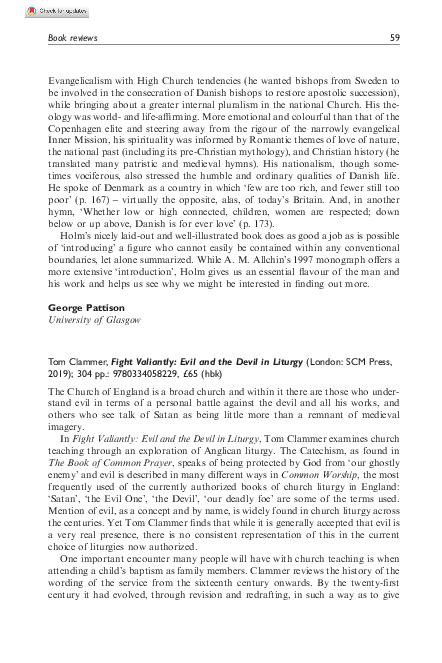Academia.edu no longer supports Internet Explorer.
To browse Academia.edu and the wider internet faster and more securely, please take a few seconds to upgrade your browser.
Tom Clammer, Fight Valiantly: Evil and the Devil in Liturgy
Related Papers
2018 •
2020 •
Honours Dissertation
The Eclipse of the Individual: Søren Kierkegaard, Varg Vikernes and the Scandinavian Church2017 •
This dissertation offers an in-depth analysis of the criticism Vikernes and Kierkegaard direct toward the tendency of institutional Christianity to negate individual identity. For Vikernes, this tendency is exemplified in the way in which Christianity was introduced to Norway in the 11th century, and its subsequent expansion at the cost of traditional Norse religion. Different regions within Norway had different rites and customs, and Vikernes blames the Church and state for eradicating these traditions and enforcing a ideology of conformity on a people for whom the concept of monotheism was alien. Christianity in Kierkegaard’s Copenhagen was similarly bound to the power of the state, but the history of its arrival in Denmark was far less violent and conflict-ridden. As a result of the close relationship between Christianity and political influence, Kierkegaard felt that the essence of faith as being a primarily individual matter was diluted. In its place stood a thoroughly mediocre and anti-Christian institution of deified civilized customs and tepid morality.
An English summary of my doctoral dissertation published in Swedish in 2008. The title of the dissertation is Den unge Manfred Björkquist. Hur en vision av kristendomens möte med kultur och samhälle växer fram.
2002 •
Networks and Neighbours
Marie Bønløkke Spejlborg, Anglo-Danish Connections and the Organisation of the Early Danish Church: Contribution to a Debate, Networks & Neighbours 2.1 (2014): 71-86From the late tenth century the external activities of Danish kings and magnates were focused on England. In the course of the following decades significant and wide-ranging contacts were forged. This paper will examine the role Anglo-Danish connections may have played in the formation of the Danish Church in the first half of the eleventh century. It considers the historical evidence of English presence on the ecclesiastical scene in Denmark from the late tenth century into the eleventh and suggests that the picture of English influence on early Danish church organisation is more complex than previously supposed.
The Journal of Ecclesiastical History
Thomas Cranmer. By Susan Wabuda. (Routledge Historical Biographies.) Pp. xxvi + 261. New York–Abingdon: Routledge, 2017. £90. 978 0 415 50077 72018 •
Presentation for a Rostock-Copenhagen joint seminar on the Reformation (May 22-23). Through a comparison between the specific regulations on preaching in the Danish Church Ordinance and the postils of Christiern Pedersen and Hans Tausen, it is shown, that the postil of Hans Tausen was designed specifically and in tandem with the Church Ordinance in order to provide for the rural pastors. The comparison also shows, tentatively, that the association between the preaching of certain themes and particular days throughout the liturgical year, was intended to create new habitual associations to supplement the already existing tradition of preaching on certain themes on particular days.
Ditlev Gothard Monrad is the author of the Danish constitution and a contemporary of Kierkegaard. This paper describes Kierkegaard’s direct references to Monrad in four journal entries and it offers an account of Kierkegaard’s views on the People’s Church of Denmark as well as his conception of the political in light of the 1848-1849 revolution in Denmark. In short, Kierkegaard recognizes little to no distinction between the State Church and the People’s Church of Denmark, and he had hoped that the political events in 1848-9 would result in the reintroduction of Christianity only to recognize that it did not later in life.
RELATED PAPERS
THE MACMILLAN COMPANY NEW YORK • BOSTON • CHICAGO DALLAS • SAN FRANCISCO
A history of Persia - Percy Molesworth Sykes -- an Exhaustive look into Persian, Sumerian , Median , Elam , Iranian , Parthian ,Aryan , Lydian , Roman , Seleucid , Macedonian , Bactrian, empires With Maps and 82 + Detailed illustrations of Ancient Citys - Relics- Beautiful Art - Mythology- PeopleThe Ecumenical Review
The Orthodox Understanding of Marriage in the Ecumenical Context2020 •
台灣切片 想像式前衛:1960s的電影實驗 Taiwan Spectrum Imagining the Avant-Garde: Film Experiments of the 1960s
黃永松專訪2018 •
2013 •
2024 •
2022 •
2019 •
Revista española de cardiología
New evidence, new controversies: a critical review of the European Society of Cardiology 2010 clinical practice guidelines on atrial fibrillation2012 •
Human Reproduction Open
Self-management strategies to consider to combat endometriosis symptoms during the COVID-19 pandemic2020 •
Proceedings of the National Academy of Sciences
A lymphocyte-activating monoclonal antibody induces regression of human tumors in severe combined immunodeficient mice1997 •

 Ted Harrison
Ted Harrison